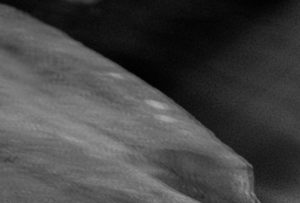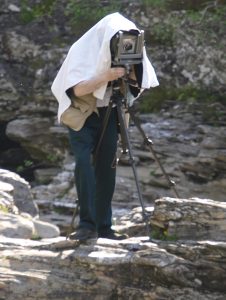What it is
This is rather similar to subject movement, in that what matters is the amount of movement recorded in the image. Like subject movement, the effect will be increased by a long focal length (in this case because the image is magnified by a longer focal length) and the degree of enlargement that you apply.
Most people have a very sanguine view of the length of time that they can hold a camera steady. The normally quoted figure for safe hand holding is to use a shutter speed which is the reciprocal of the focal length – so, for example, you could use 1/30 second with a 30mm lens, and need 1/200 with a 200mm lens. These figures were used when people used 35mm cameras, and are based on the probable degree of enlargement. With an APS-C sized DSLR, the degree of magnification to give an equal sized print is almost twice that for 35mm, so the shutter speed should be halved. For digital compacts where the sensor is even smaller, the case is worse. Larger lenses will have a different size and balance, and will for this reason alone be more prone to camera shake; their greater image magnification will then make matters even worse. Shorter focal length lenses are not only smaller and lighter, but have a better balance and reduce the image size, all making for more shake free results. Carried to the extreme wide angle end, though, the lens sizes increase again.
I have no illusions that I can manage to hand hold at these speeds (or their equivalent). I know that unless I use 1/250 with a 50mm lens on a 35mm camera, I will notice the difference. Others say that they can hand hold longer lenses on smaller formats at 1/30 second or less. It’s quite possible that they can. People differ, and no general rule can be certain to apply to you.
Recognising Camera Shake
Many people find it difficult to identify softness due to camera shake as opposed to that produced by an image being slightly out of focus, so here’s an example.

The photograph looks soft even at this small scale of reproduction, but if the trees (top centre of the photograph) are enlarged, the cause of the unsharpness is evident.

The give away is the double image evident in the branches. If the double image is seen only on some objects, then subject movement will be the cause. In the above photograph, the trunks would hardly move in that way, and if the edge of the rocks at the bottom right is also examined, the same effect can be seen there.

Strange as it may seem, the camera was actually on a tripod. The photograph was taken in Glen Orchy in Scotland, and I was standing on the rocks in the stream bed.

As you can see, my legs and the tripod’s were entwined, and in moving as I released the shutter I caught the leg of the tripod, resulting in the blurred image.
Testing your ability to hand hold a camera
A simple way to test your ability to handhold is to set up a torch (or other light source) behind a small hole in a piece of card in a darkened room, and focus on the point of light. If you take a series of exposures (not just one – at least three) at each shutter speed that you would consider using with a hand held camera, you will be easily able to see whether or not you can handhold at that speed – either every time, most of the time, or never.
This same test can also be used to see how effective your tripod is when different shutter speeds are used. If there is a small amount of vibration caused by the mirror in your camera, this can show up as shake in exposures of moderate length (say 1/30 sec or thereabouts) but not appear with longer ones, where most of the exposure will take place after the vibrations have dampened down